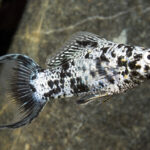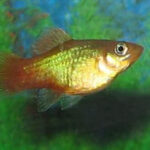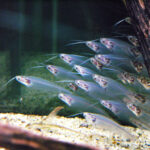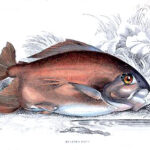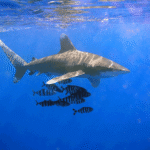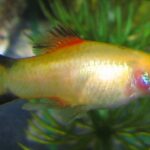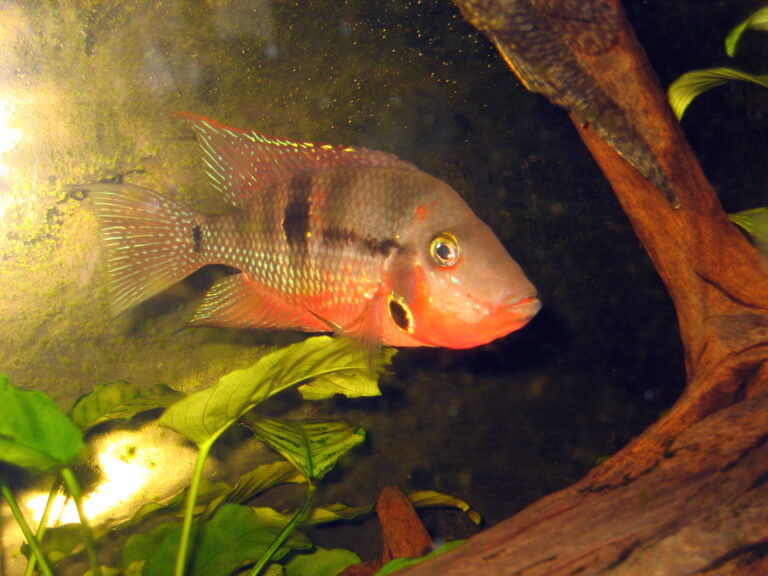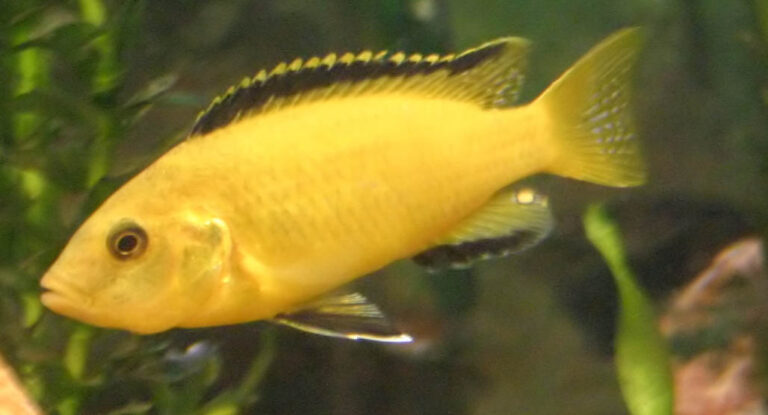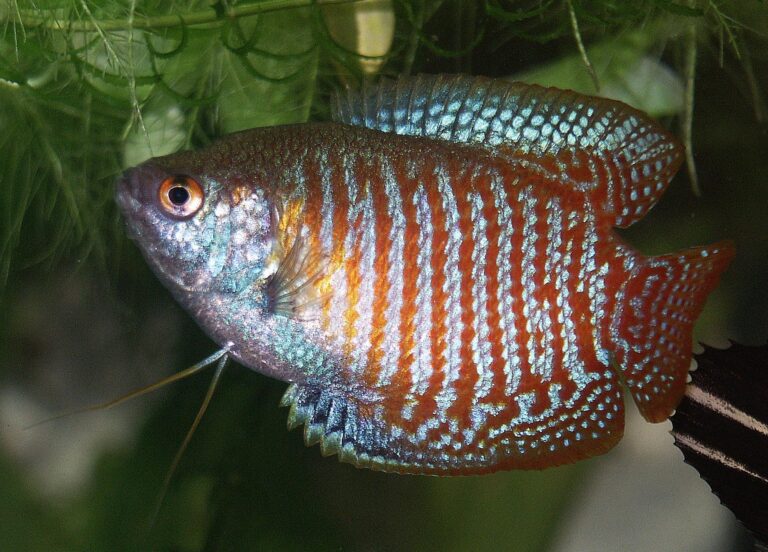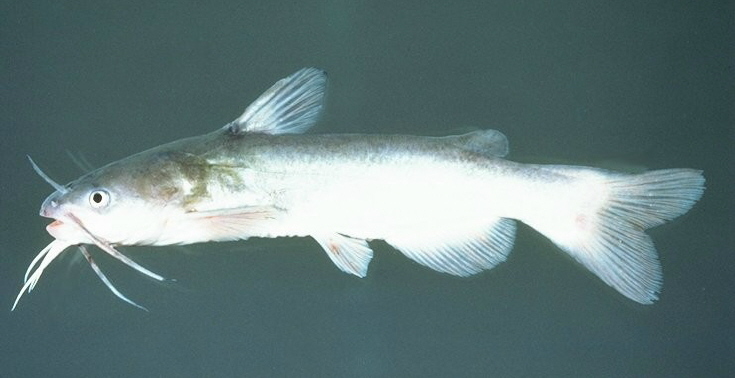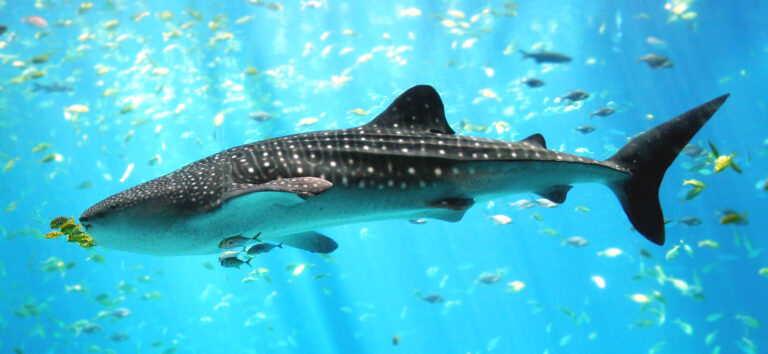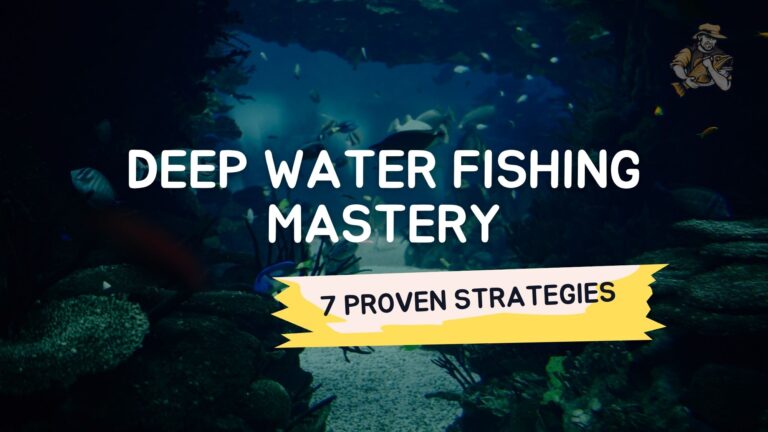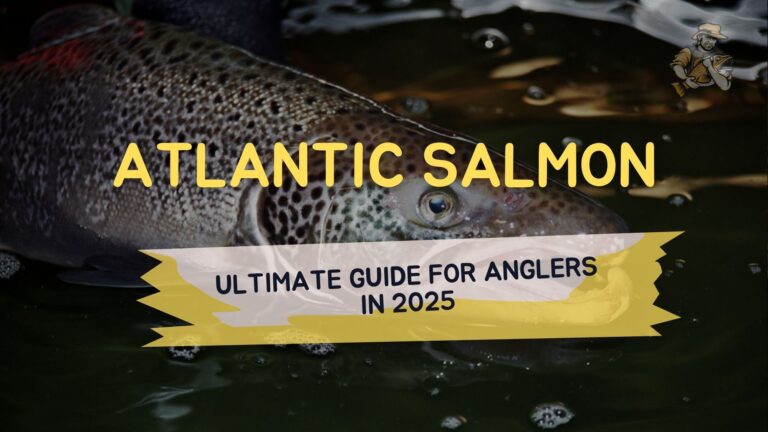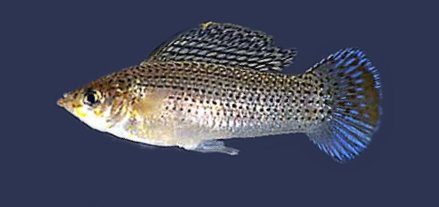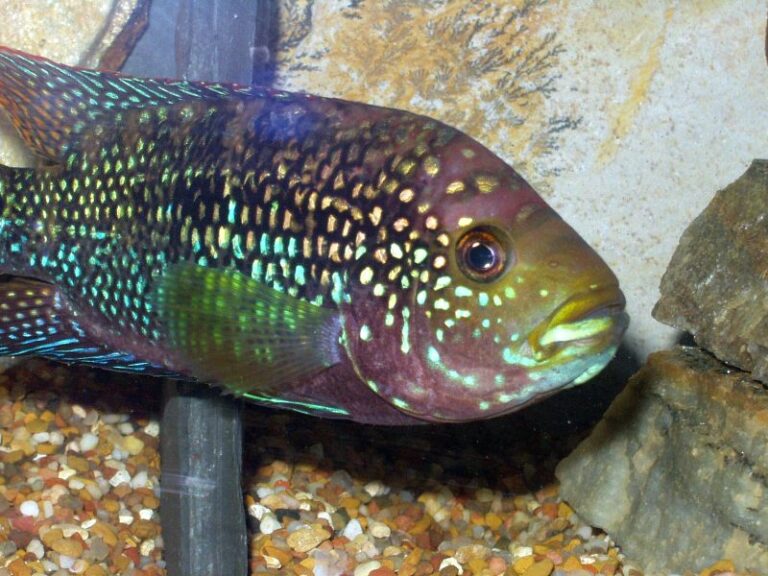Guppy
By Ryan Maron | Last Modified: June 4, 2025
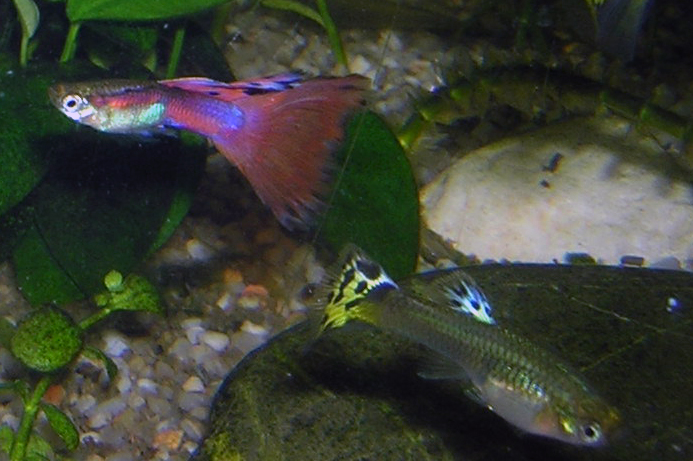
The Guppy (Poecilia reticulata) stands as one of the most recognizable and extensively studied freshwater fish species in the world. This small tropical fish, native to South America, has become a cornerstone species in both aquarium keeping and scientific research. Guppies hold particular significance in evolutionary biology studies due to their rapid reproduction rates and remarkable genetic diversity. Their ecological role as both predator and prey makes them crucial components of freshwater ecosystems, helping control mosquito larvae populations while serving as food sources for larger aquatic predators.
| Feature | Details |
|---|---|
| Common Name | Guppy |
| Scientific Name | Poecilia reticulata |
| Family | Poeciliidae |
| Typical Size | 2.5-6.0 cm (1-2.4 inches), 0.1-0.25 grams |
| Habitat | Shallow freshwater streams and pools |
| Diet | Omnivorous micropredator |
| Distribution | South America, introduced worldwide |
| Conservation Status | Least Concern |
Taxonomy & Classification
The Guppy belongs to the family Poeciliidae, commonly known as livebearers, within the order Cyprinodontiformes. Originally described by Wilhelm Peters in 1859, Poecilia reticulata has undergone several taxonomic revisions throughout scientific history. The species was initially classified under the genus Lebistes before being reassigned to Poecilia based on morphological and genetic analyses.
Within the Poeciliidae family, guppies are closely related to mollies, platies, and swordtails. The genus Poecilia encompasses approximately 40 recognized species, with P. reticulata being the most widely distributed and studied. Recent molecular phylogenetic studies have confirmed the monophyletic nature of the genus while revealing complex evolutionary relationships among Caribbean and South American populations.
The subspecific classification of guppies remains a subject of ongoing scientific debate. Some researchers recognize distinct subspecies based on geographic distribution and phenotypic variations, while others argue for a single polytypic species. This taxonomic uncertainty reflects the species’ remarkable phenotypic plasticity and rapid evolutionary adaptation to local environmental conditions.
Physical Description
Guppies exhibit pronounced sexual dimorphism, with males and females displaying distinctly different morphological characteristics. Adult males typically measure 1.5-3.5 centimeters in length, while females grow larger at 2.5-6.0 centimeters. This size difference reflects the species’ reproductive strategy, where larger females can produce more offspring.
Male guppies are renowned for their vibrant coloration and elaborate finnage. Their bodies display combinations of red, orange, yellow, blue, green, and black pigmentation arranged in species-specific patterns. The caudal fin of males is particularly striking, often featuring intricate geometric designs, spots, or stripes. The gonopodium, a modified anal fin used for reproduction, serves as a key identifying feature of mature males.
Female guppies present more subdued coloration, typically exhibiting gray or brown base colors with minimal patterning. Their bodies are deeper and more robust than males, adapted for carrying developing embryos. The gravid spot, a dark triangular area near the anal fin, becomes prominent during pregnancy and serves as an external indicator of reproductive status.
The species demonstrates remarkable phenotypic variation across different populations. Wild guppies from high-predation environments tend to be smaller and less colorful than those from low-predation habitats. This variation has made guppies invaluable for studying evolutionary ecology and sexual selection processes.
Habitat & Distribution
Native to the freshwater systems of northeastern South America, wild guppy populations naturally occur in Venezuela, Guyana, Suriname, French Guiana, Brazil, Barbados, and Trinidad and Tobago. The species inhabits a diverse range of freshwater environments, from mountain streams to coastal lowland waters. Natural habitats typically feature shallow, slow-moving waters with temperatures ranging from 20-28°C and pH levels between 6.0-8.5.
Guppies demonstrate remarkable adaptability to varying environmental conditions. They thrive in habitats with different predator densities, water chemistry parameters, and food availability. This ecological flexibility has contributed to their success as an introduced species in tropical and subtropical regions worldwide.
Human introductions have established guppy populations across six continents, excluding Antarctica. These introductions, often initiated for mosquito control purposes, have created naturalized populations in countries including the United States, Australia, Japan, and numerous tropical islands. The species’ tolerance for brackish water has enabled colonization of estuarine environments and coastal freshwater systems.
The fragmented nature of many guppy habitats, particularly in their native range, has led to the evolution of distinct local adaptations. Stream systems separated by waterfalls or other barriers often harbor genetically differentiated populations, making guppies excellent models for studying adaptive radiation and speciation processes. As detailed in our guide to California fishing spots, understanding native fish distributions helps anglers appreciate ecosystem complexity.
Diet & Feeding Behavior
Guppies function as omnivorous micropredators within freshwater ecosystems, consuming a diverse array of small organisms and organic matter. Their diet consists primarily of invertebrates including mosquito larvae, chironomid larvae, copepods, cladocerans, and various aquatic insects. Plant material, algae, and detritus supplement their animal protein intake, particularly during periods of reduced prey availability.
Feeding behavior varies significantly based on environmental conditions and predation pressure. In high-predation environments, guppies exhibit more cautious foraging patterns, spending less time in exposed areas and showing increased vigilance while feeding. Conversely, populations from low-predation habitats display bolder feeding behaviors and spend more time actively searching for prey.
The species demonstrates remarkable behavioral plasticity in response to food availability. During periods of abundance, guppies show selective feeding preferences, targeting high-quality prey items. When food becomes scarce, they adopt more generalist feeding strategies, consuming lower-quality items including plant material and detritus.
Guppies play a crucial ecological role in controlling disease vector populations, particularly mosquito larvae. Studies have documented significant reductions in Aedes and Anopheles mosquito densities in habitats where guppies have been introduced for biological control purposes. This ecosystem service has made them valuable allies in public health initiatives across tropical regions.
The feeding behavior of guppies also influences their social structure and schooling patterns. Groups often coordinate their foraging activities, with individuals following successful foragers to productive feeding sites. This social facilitation enhances foraging efficiency and reduces individual predation risk through the dilution effect.
Behavior & Adaptations
Guppies exhibit complex behavioral repertoires that reflect their evolutionary adaptations to diverse ecological pressures. Schooling behavior represents one of their most prominent social adaptations, providing protection against predators through the selfish herd effect and increased vigilance. School composition varies dynamically based on environmental conditions, with tighter aggregations forming in response to predator presence.
The species demonstrates remarkable cognitive abilities for such a small fish. Laboratory studies have documented their capacity for numerical discrimination, spatial learning, and social learning transmission. Guppies can recognize individual conspecifics and adjust their behavior based on previous social interactions, indicating sophisticated social cognition.
Predator recognition and avoidance behaviors show considerable variation among populations with different evolutionary histories. Guppies from high-predation environments exhibit innate fear responses to predator cues, while those from predator-free habitats must learn to recognize threats. This behavioral plasticity reflects rapid evolutionary adaptation to local selective pressures.
Territorial and aggressive behaviors become prominent during breeding periods, particularly among males competing for access to females. Dominant males establish temporary territories around feeding sites or potential spawning areas, defending these resources through displays and direct aggression. Subordinate males often employ alternative reproductive strategies, including sneaky mating attempts.
The species’ remarkable adaptability extends to physiological tolerances. Guppies can survive in waters with dissolved oxygen levels as low as 1.0 mg/L and tolerate temperature fluctuations from 15-35°C. This physiological flexibility, combined with their behavioral adaptability, explains their success as colonizers in diverse environments worldwide.
Reproduction & Life Cycle
Guppies employ a livebearing reproductive strategy that distinguishes them from most freshwater fish species. Females undergo internal fertilization and carry developing embryos for approximately 21-30 days, depending on water temperature and nutritional status. This reproductive mode provides several advantages, including protection of developing young and the ability to time births to favorable environmental conditions.
Sexual maturity occurs rapidly in guppies, with males reaching reproductive capability at 2-3 months of age and females maturing slightly later at 3-4 months. This early maturation, combined with short generation times, enables rapid population growth under favorable conditions. Females can store sperm from multiple males for several months, allowing production of multiple broods from a single mating event.
Brood sizes vary considerably based on female size, age, and environmental conditions. Young females typically produce 10-20 offspring per brood, while mature females can deliver 50-100 fry. Larger females generally produce larger broods, creating strong selective pressure for increased female body size.
Male reproductive behavior centers around elaborate courtship displays designed to attract females while avoiding detection by predators. Courtship intensity varies among populations, with males from low-predation environments displaying more conspicuous behaviors than those from high-predation habitats. This variation demonstrates the evolutionary trade-off between sexual selection and natural selection pressures.
Guppy reproduction provides classic examples of sexual selection processes. Female mate choice based on male coloration and display behavior drives the evolution of elaborate male phenotypes. However, predation pressure constrains the evolution of conspicuous traits, creating a dynamic balance between opposing selective forces.
The species exhibits remarkable reproductive plasticity in response to environmental stressors. Under adverse conditions, females can delay reproduction, reabsorb developing embryos, or produce smaller broods to conserve energy. This flexibility enhances survival during challenging environmental periods.
Predators & Threats
Guppies face predation pressure from a diverse array of aquatic predators throughout their geographic range. Primary predators include larger fish species such as cichlids, characins, and other poeciliids, along with aquatic invertebrates including diving beetles, dragonfly nymphs, and freshwater shrimp. The intensity of predation varies dramatically among habitats, creating strong selective pressures that shape guppy evolution.
Avian predators, particularly kingfishers and herons, represent significant threats to guppies in shallow-water habitats. These visual predators target conspicuous individuals, creating selective pressure against bright coloration and promoting the evolution of cryptic phenotypes in exposed environments.
Human activities pose increasingly significant threats to wild guppy populations. Habitat destruction through deforestation, agricultural expansion, and urbanization eliminates critical breeding and foraging areas. Water pollution from agricultural runoff, industrial discharge, and domestic waste degrades water quality and reduces population viability.
Climate change presents emerging challenges for guppy populations, particularly those in mountainous regions where temperature increases may exceed physiological tolerance limits. Altered precipitation patterns affect stream flow regimes, potentially fragmenting populations and reducing habitat availability.
Introduced species represent both direct and indirect threats to native guppy populations. Non-native predators can eliminate local populations, while introduced competitors may reduce resource availability. Conversely, guppies themselves function as invasive species in many regions, potentially impacting native fish communities through competition and predation.
Disease outbreaks can devastate guppy populations, particularly in high-density environments. Viral, bacterial, and parasitic infections spread rapidly through schooling populations, with climate change potentially increasing disease prevalence by stressing immune systems and altering pathogen distributions.
Conservation Status
The International Union for Conservation of Nature (IUCN) currently classifies the Guppy as Least Concern due to its widespread distribution and stable global population. However, this broad classification masks concerning trends in native populations, where localized extinctions and population declines have been documented across portions of the species’ natural range.
Conservation challenges for guppies differ significantly between native and introduced populations. In their native South American range, habitat degradation poses the primary threat to wild populations. Deforestation in watershed areas increases sedimentation and alters water chemistry, while agricultural activities introduce pesticides and fertilizers that degrade aquatic habitats.
Several native guppy populations have been identified as conservation priorities due to their unique genetic characteristics and restricted distributions. These populations often harbor distinct evolutionary adaptations that could be lost if local extinctions occur. Conservation efforts focus on habitat protection and restoration within critical watershed areas.
The paradoxical conservation status of guppies reflects their dual role as threatened native species and successful invasive species. While native populations face decline, introduced populations thrive in many regions, sometimes at the expense of endemic species. This situation complicates conservation planning and resource allocation decisions.
Climate change projections suggest increasing challenges for high-altitude guppy populations in their native range. Temperature increases may force these populations to migrate to higher elevations or face local extinction. Conservation strategies must account for these projected changes and identify climate refugia for vulnerable populations.
Captive breeding programs maintain genetic diversity of wild guppy strains, though most focus on commercial varieties rather than conservation of native genotypes. Collaborative efforts between aquarium enthusiasts, researchers, and conservation organizations could enhance preservation of wild genetic diversity while maintaining the species’ commercial value.
Human Interaction
The relationship between humans and guppies spans multiple centuries and encompasses various practical, commercial, and scientific applications. Historical introductions for mosquito control beginning in the early 20th century established guppy populations worldwide, demonstrating early recognition of their ecological utility. These biocontrol programs achieved notable success in reducing disease-carrying mosquito populations across tropical regions.
The aquarium trade represents one of the most significant human interactions with guppies, generating millions of dollars annually in global commerce. Selective breeding has produced hundreds of ornamental varieties displaying enhanced coloration, modified finnage, and altered body proportions. This commercial activity supports livelihoods across producing countries while maintaining genetic resources for potential conservation applications.
Scientific research utilizes guppies extensively as model organisms for studying evolution, ecology, and behavior. Their rapid reproduction, genetic diversity, and behavioral complexity make them ideal subjects for laboratory and field studies. Research findings from guppy studies have contributed fundamental insights into evolutionary biology, sexual selection, and ecological adaptation processes.
Educational applications of guppies extend from elementary school science classes to graduate-level university courses. Their ease of maintenance, observable behaviors, and rapid life cycles make them excellent teaching tools for demonstrating biological concepts. Many students receive their introduction to aquatic biology through interactions with classroom guppy populations.
NOAA Fisheries monitors guppy populations in areas where they may impact native species, while USGS research centers study their ecological effects in introduced habitats. These efforts provide crucial data for managing human-guppy interactions sustainably.
Cultural significance varies among regions, with some communities viewing guppies as beneficial allies in disease control while others consider them aquatic pests. Understanding these diverse perspectives helps inform management decisions and conservation strategies. The species’ role in beginner fishing education continues to introduce new generations to aquatic ecosystems.
Interesting Facts
Guppies possess several remarkable characteristics that distinguish them among freshwater fish species. Their ability to see ultraviolet light enables detection of subtle environmental cues invisible to human observers. This visual capability influences mate selection, predator detection, and foraging behavior in ways that researchers are still discovering.
The mathematical precision of guppy schooling behavior demonstrates sophisticated collective intelligence. Individual fish can assess group density, direction of movement, and threat levels to make split-second decisions about school participation. These calculations occur without centralized coordination, representing emergent properties of simple individual rules.
Female guppies exhibit the unusual ability to control paternity of their offspring through selective sperm usage. After mating with multiple males, females can preferentially utilize sperm from preferred partners, effectively exercising post-copulatory mate choice. This mechanism allows optimization of offspring genetic quality even after mating has occurred.
Temperature-dependent sex determination occurs in some guppy populations, where environmental temperature during early development influences offspring sex ratios. This phenomenon, more commonly associated with reptiles, demonstrates the species’ reproductive flexibility and adaptation to environmental variability.
Guppies can survive brief periods out of water by utilizing cutaneous respiration through their skin. This adaptation enables movement between isolated pools during dry seasons and survival in oxygen-depleted environments where other fish species cannot persist.
The species demonstrates remarkable learning abilities, including the capacity to count up to four and recognize human faces. Laboratory studies have documented their ability to navigate complex mazes and remember solutions for extended periods. These cognitive abilities challenge traditional assumptions about fish intelligence and consciousness.
Color vision in guppies surpasses human capabilities, encompassing not only ultraviolet wavelengths but also providing tetrachromatic color perception. This enhanced visual system enables discrimination of subtle differences in food quality, predator types, and potential mates that would be invisible to human observers.
Frequently Asked Questions
How long do guppies typically live in their natural habitat?
Wild guppies generally live 12-18 months in their natural environment, though lifespans vary significantly based on predation pressure, environmental conditions, and population density. Females typically live longer than males due to reduced predation risk associated with their less conspicuous coloration and larger body size.
Can guppies survive in saltwater environments?
Guppies possess moderate salinity tolerance and can survive in brackish water with salt concentrations up to 15 parts per thousand. However, they cannot survive in full-strength seawater and require gradual acclimation when transitioning between freshwater and brackish environments. This tolerance has enabled colonization of estuarine habitats in some regions.
What role do guppies play in mosquito control programs?
Guppies serve as biological control agents by consuming mosquito larvae in breeding habitats such as water storage containers, irrigation channels, and temporary pools. A single adult guppy can consume 100-300 mosquito larvae per day, making them highly effective at reducing disease vector populations. However, their introduction must be carefully managed to avoid negative impacts on native ecosystems.
How do wild guppies differ from aquarium varieties?
Wild guppies display more subdued coloration, smaller fins, and greater behavioral wariness compared to selectively bred aquarium strains. They maintain stronger schooling instincts, exhibit more pronounced predator avoidance behaviors, and possess greater genetic diversity. Wild populations also show remarkable local adaptations that are absent in commercial breeding lines, as discussed in our comprehensive guide to betta fish varieties.
Conclusion
The Guppy represents a remarkable example of evolutionary adaptability and ecological significance within freshwater ecosystems. From their native South American waters to introduced populations worldwide, these small fish continue to provide valuable insights into fundamental biological processes while serving practical roles in disease control and scientific research. Their conservation requires balancing protection of native populations with management of introduced ones, ensuring this species continues contributing to both natural ecosystems and human knowledge for generations to come.
Share The Article:
More Fish Species:
-
Firemouth Cichlid
The Firemouth Cichlid (*Thorichthys meeki*) stands as one of Central America’s most recognizable freshwater fish species, distinguished by its…
-
Yellow Lab Cichlid
The Yellow Lab Cichlid (*Labidochromis caeruleus*) stands as one of Africa’s most recognizable freshwater fish species, distinguished by its…
-
Red Devil Cichlid
The Red Devil Cichlid stands as one of Central America’s most formidable and captivating freshwater predators, renowned for its…
-
Gouramis
Gouramis represent one of the most fascinating and diverse groups of freshwater fish, belonging to the family Osphronemidae within…
-
White Catfish
The White Catfish represents one of North America’s most adaptable freshwater species, serving as both an important commercial fish…
-
Whale Shark
The whale shark (*Rhincodon typus*) stands as the ocean’s largest fish species, representing one of nature’s most remarkable gentle…
Discover
-
King Mackerel Fishing: Top Strategies for Landing Smokers
Some days on the water just stick with you. Few things compare to that first time a king mackerel…
-
Louisiana Redfish Fishing: Best Spots & Tactics for Beginners
Finding that first bull red is a moment you never forget. The pull, the power – it’s something special….
-
Deep Water Fishing Mastery: 7 Proven Strategies
When surface waters turn quiet and shoreline spots fail to produce, the answer often lies in the depths. Deep…
-
7 Shark Fishing Tactics That Actually Work (Expert Guide)
Shark fishing remains one of those bucket-list experiences that separates casual anglers from the truly adventure-hungry. But here’s the…
-
Atlantic Salmon: Ultimate Guide for Anglers in 2025
For as long as I can remember, I’ve been captivated by Atlantic salmon fishing. There’s something almost mystical about…
-
North Jersey Fishing Guide: Best Lakes, Rivers & Seasons
If you’ve never experienced the fishing in North Jersey, you’re missing out on some genuinely underrated angling opportunities. From…
Discover
-
Winter Fishing Tips: 7 Cold-Weather Tactics Successful Anglers Use
Most anglers pack away their gear when the temperature drops, but the dedicated few know something the others don’t:…
-
River Fishing Techniques: Master the Moving Water
Fishing rivers presents a unique set of challenges and rewards that I’ve come to appreciate over my three decades…
-
Night Fishing for Beginners: Expert Techniques That Actually Work
My first night fishing trip was an absolute disaster. Picture this – fifteen-year-old me, armed with a rusty flashlight…
-
Molly Fish
The Molly Fish represents one of the most adaptable and ecologically significant freshwater species in tropical and subtropical regions…
-
Beluga Fishing: Techniques That Actually Work (Not Theory)
When it comes to beluga fishing, there’s a world of difference between what you read in theory and what…
-
Jack Dempsey Fish
The Jack Dempsey Fish stands as one of Central America’s most distinctive cichlid species, captivating aquarists and researchers alike…


